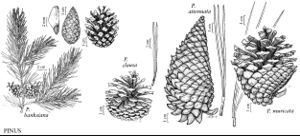Pinus clausa
Rep. For. N. America 199. 1884.
Trees to 21m; trunk to 0.5m diam., straight and erect to leaning and crooked, much branched; crown mostly rounded or irregular. Bark gray to gray-brown, furrowed, with narrow, flat, irregular ridges, resin pockets absent, on upper sections of the trunk reddish to redbrown, platy becoming smooth distally. Branches spreading to ascending, poorly self-pruning; twigs slender, violet to redbrown, rarely glaucous, aging gray, smooth. Buds cylindric, purple-brown, to 1cm; scale margins white-fringed. Leaves 2 per fascicle, spreading-ascending, persisting 2–3 years, (3–) 6–9 (–10) cm × ca. 1mm, straight, slightly twisted, dark green, all surfaces with fine, inconspicuous stomatal lines, margins finely serrulate, apex short-conic; sheath 0.3–0.5 (–0.7) cm, base persistent. Pollen cones ellipsoid, ca. 10mm, brownish yellow. Seed-cones maturing in 2 years, shedding seeds soon thereafter or often long-serotinous, long-persistent, solitary or whorled, spreading, symmetric (rarely slightly asymmetric, reflexed), lanceoloid before opening, ovoid to broadly ovoid when open, 3–8cm, redbrown, sessile or on stalks to 1cm, scales with dark redbrown, purple, or purple-gray border distally on adaxial surface; apophyses thickened, shallowly and angulately raised, transversely rhombic, cross-keeled; umbo central, low-pyramidal, tapering to sharp tip or weak, often deciduous prickle. Seeds obovoid-oblique; body ca. 4mm, dark-brown to nearly black; wing to 17mm. 2n =24.
Habitat: Fire successional in sand dunes and white sandhills
Elevation: 0–60m
Discussion
Although Pinus clausa is too profusely branched to be important for saw timber, it is managed to produce a high volume of pulpwood in northern peninsular Florida.
Selected References
None.

